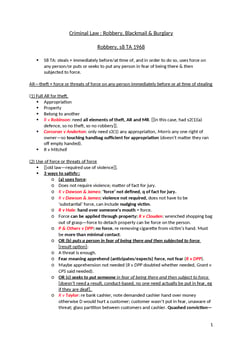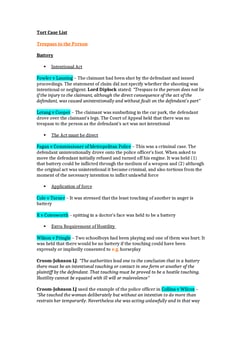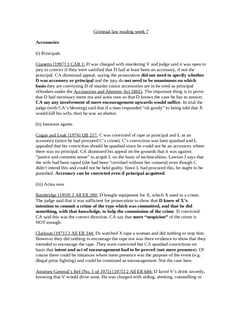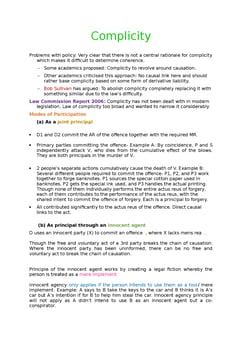Haystead v Chief constable of Derbyshire [2000] 3 All ER 890
Judgement for the case Haystead v Chief constable of Derbyshire
Table Of Contents
KEY POINTS
Battery involves the actus reus, which encompasses the physical act or conduct that constitutes the offense. Reckless battery occurs when the assailant acts with a blatant disregard for consequences, knowingly putting the victim at risk of harm.
The direct application of force is crucial, necessitating the assailant to have direct physical contact with the victim.
Battery can manifest through a medium controlled by the assailant's actions, such as an object or substance manipulated by them. This signifies that contact leading to the offense can be established either through direct interaction with the victim's body or indirectly through a medium under the control of the assailant.
FACTS
W lived with her approximately 12-month-old child and had previously been in a relationship with the appellant but ended it. The John Andrew Haystead (‘Appellant’) visited W's home two days later and was allowed inside.
During this visit, he punched W while she was holding her child. As a direct consequence of the punches, the child fell from W's arms and hit his head on the floor.
The Appellant was charged, among other charges, with common assault by beating.
During the magistrates' court proceedings, the appellant argued for a submission of no case to answer. He contended that for guilt in battery, it was necessary to prove he had directly used force on the child, which, according to him, was not evident in the provided evidence.
The Respondent conceded that there was no direct violence intended towards the child. However, they argued that the Appellant's reckless actions towards the mother resulted in violence that caused the child to fall, constituting direct violence to the child.
The magistrates found that the child was visible to the Appellant, and he should have foreseen the risk of the child being injured. Consequently, they convicted the Appellant.
Dissatisfied, the Appellant appealed the conviction by way of a case stated.
JUDGEMENT
The Appeal was dismissed, with the judgment holding that while most batteries typically involve direct infliction, it was not essential for the violence to be so directly applied.
The court recognized that the direct application of force could occur through a medium controlled by the Assailant's actions. In the specific case at hand, W had lost hold of the child as an immediate result of the appellant's action in punching her.
The court emphasized that there was no difference in logic or good sense between the facts of the present case and a scenario where the assailant used a weapon to cause the child to fall to the floor, except that the present case involved reckless, not intentional, battery.
Therefore, it was deemed unequivocally correct that the offense of assault by beating should be available for the criminal condemnation of the Appellant's conduct.
COMMENTARY
John Andrew Haystead visited W, his former partner, and punched her while she held their 12-month-old child, causing the child to fall and hit his head. The Appellant faced charges, including common assault by beating.
In the magistrates' court, the Appellant argued that direct evidence of force on the child was lacking for guilt in battery. The Respondent acknowledged no direct violence but argued the Appellant's recklessness caused the child's fall, constituting direct violence.
-
The magistrates, noting the child was visible and the risk foreseeable, convicted the Appellant. His appeal was dismissed.
The judgment stressed that while batteries often involve direct infliction, it's not necessary. Force, controlled by the assailant, can cause harm indirectly.
In this case, the child's fall resulted from the Appellant's reckless actions, akin to a scenario involving a weapon.
The court affirmed the availability of the offense of assault by beating for condemning the Appellant's conduct.
ORIGINAL ANALYSIS
The defendant punched a woman holding a child, causing her to drop the child and thereby cause it damage.
He was convicted of battery to the child and appealed, but his appeal was dismissed.
The CA said that transferred malice did not apply.
The defendant said that in battery it was necessary to have directed the assault against the child directly since the wording of the offence was “… an act by which a person intentionally or recklessly applies unlawful force to the complainant.”
The appeal was dismissed since battery can be applied through a medium of a weapon and given that the mother’s dropping the baby was akin to that. (If direct force is required against the baby then he should be acquitted: the mother’s dropping him is hardly a weapon)
For Further Study on Haystead v Chief constable of Derbyshire

A collection of the best GDL notes the director of Oxbridge Notes (an O...

A collection of the best GDL notes the director of Oxbridge Notes (an O...

Criminal Law notes fully updated for recent exams at Oxford and Cambrid...
Need instant answers? Our AI exam tutor is here to help.
Ask questions 🙋 Get answers 📔 It's simple 👁️👄👁️
Our AI is educated by the highest scoring students across all subjects and schools. Join hundreds of your peers today.
Get StartedRelated Product Samples
These product samples contain the same concepts we cover in this case.

 Since 2010, Oxbridge Notes has been a trusted education marketplace, supplying high-quality materials from top achievers at universities like Oxford, Cambridge, LSE, Harvard, and Yale.
Since 2010, Oxbridge Notes has been a trusted education marketplace, supplying high-quality materials from top achievers at universities like Oxford, Cambridge, LSE, Harvard, and Yale.